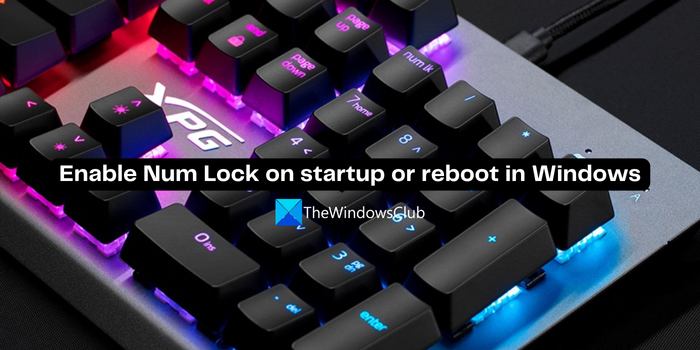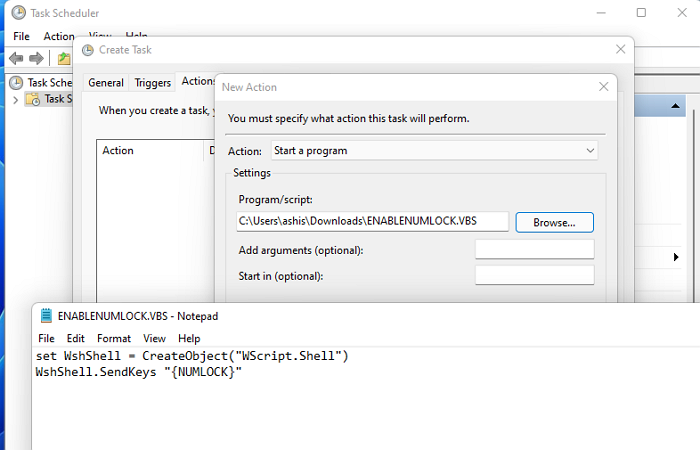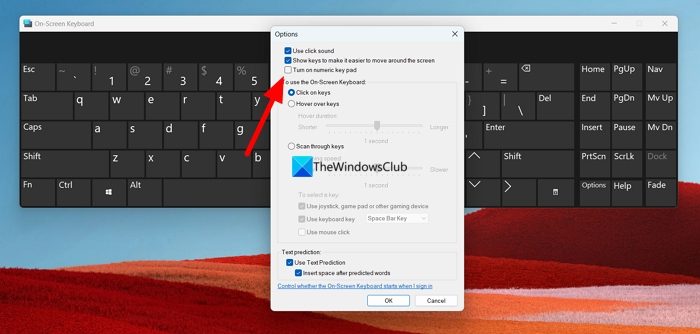A relatively common issue being faced by some Windows users is finding that their Numeral Lock key or Num Lock is not enabled, is turned off, not working, or inactive on Startup or reboot in Windows 11/10. In this guide, we show you how you can enable the Num Lock on Startup or reboot in Windows 11/10. You can also use the following guide to fix when Num Lock is not working on Startup on Windows.

Num Lock not working on the Startup
For those who do not know what Fast Startup is, here is a short description. The feature is called Hybrid Shutdown. Windows does this by shutting down, as far as closing the user sessions – but at that point, instead of continuing and ending system services and shutting down Session 0, Windows then hibernates. It is called Hybrid Shutdown. How this works is that Windows sends out a message to running applications, giving them a chance to save data and settings. Applications can also request a little extra time to finish what they’re doing. Then Windows closes the user sessions for each logged-on user, and then it Hibernates the Windows session. Here is a little pictorial explanation.
I’m not sure how disabling Fast Startup affects Num Lock, but on systems facing this issue, disabling fast Startup did help.
Enable Num Lock on startup or reboot in Windows 11/10
If you want to enable the Num Lock on Startup or Reboot in Windows 11/10, you can use the following methods to do so.
- Disable Fast Startup to enable Num Lock
- Enable Num Lock on startup using Registry tweak
- Run NumLock Script at Startup
Let’s get into the details of each method. You will need admin permission to execute the steps.
1] Disable Fast Startup to enable Num Lock

- Press Win + X and click on Control Panel
- Click on Power Plan
- Now click on Choose what the power buttons do on the left side panel
- Now select Change settings that are currently unavailable.
- Scroll down and uncheck Turn on fast Startup (recommended)
That’s it. Now after shutting down and reboot your NumLock should retain the last configuration.
2] Enable Num Lock on Startup using Registry tweak
The second method is to alter the registry settings and so Windows 11/10 users can try this. I would strongly recommend taking a backup of the registry and create a system restore point first. Having done that, follow these steps:
- Press Win + R and type in Regedit
- Navigate to registry key HKEY_USERS\.Default\Control Panel\Keyboard
- Right-click on the “InitialKeyboardIndicators“, select Modify and change Value data to 2.
- Exit Registry.
Note: If you see the default value data as 2147483648; that is fine too and is the default on most installations.
TIP: You can easily enable, and disable Num Lock key on a Windows laptop using NumBlock
Also read: Num Lock key not working
3] Run NumLock Script at Startup
- Open the Run prompt, type Notepad, and press the Enter key
- Copy and Paste the following in the notepad, and save it with a name you can remember with the VBS extension. (e.g. enablenumlock.vbs)
set WshShell = CreateObject("WScript.Shell")
WshShell.SendKeys "{NUMLOCK}" You can then add this Script to run with Startup using the Task Scheduler.
You can then add this Script to run with Startup using the Task Scheduler.- Open Search using Win + S, type Task Scheduler and open it once it appears
- Right-click on the Task Scheduler and create a Task
- Under the General tab: Set it to run with the highest privileges and Run only when the user is logged on
- Under Actions: Click on new, and then add the Script
- Done that save the task. As soon as you log in the next time, NumLock will automatically turn on.
You can always test the Script by first turning off the num lock and then running it.
Also read: How to turn off or disable Num Lock on Windows laptop
How do I keep NumLock on at startup in Windows 11?
You can keep Num Lock on at Startup in Windows 11 in three ways. You can start by disabling Fast Startup in the Power options to enable Num Lock at the Startup, enable Num Lock by tweaking Registry settings, or run the Num Lock script at the Startup. These three methods will help you turn on Num Lock by default on the Startup in Windows 11.
How to activate Num Lock without key?

If your keyboard does not have a Num Lock key and you need to activate the Num Lock, you can use the On-Screen keyboard and use it. Open the On-Screen keyboard on your Windows 11 and click on Options. It will open the Options window. Check the button beside Turn on the numeric keypad and press OK. It will show the Num Lock key on the On-Screen keyboard. You can use the button to activate or deactivate Num Lock which will reflect on the physical keyboard.
Related read: Caps Lock or Num Lock won’t turn On or Off.



